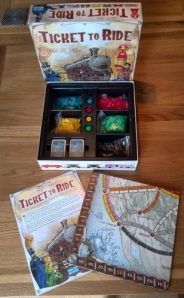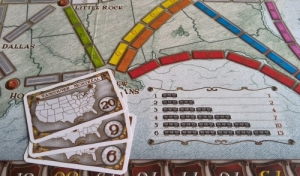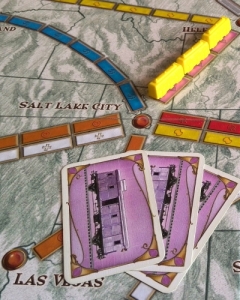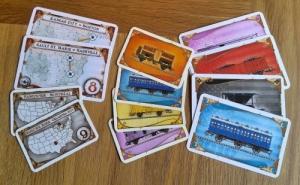 Ticket to Ride is a hugely popular family strategy board game for two to five players, retailing for around £30 – although most people outside the hobby still haven’t heard of it. It has sold more than three million copies since 2004 and spawned a string of expansions, as well as a popular browser, Apple and Android app.
Ticket to Ride is a hugely popular family strategy board game for two to five players, retailing for around £30 – although most people outside the hobby still haven’t heard of it. It has sold more than three million copies since 2004 and spawned a string of expansions, as well as a popular browser, Apple and Android app.
Often given the ‘king of the gateway games’ tag, it’s a fabulous tool to show non-gamers how great the hobby is today. But there’s also enough fun in Alan R Moon’s simple design to keep many regular gamers (including myself) coming back for more.
Games should last less than an hour and the game works well with any number, although experienced players tend to prefer different maps (bought separately) at certain player counts.
In Ticket to Ride, players collect sets of coloured train cards and use them to claim routes between cites on a large map of North America. While you’ll score victory points for these connections, each player also has a set of their own secret destination cards to complete. So when placing your routes, you can be blocking your opponents in the process – deliberately or not! And unfinished route cards will lose you points at the end of the game.
Alongside the nice game board and cards (they’re small, 68x44mm, but larger ones are available – and there’s no real text) each player gets 45 plastic train cars in their colour; these make the board look great once the game gets going. There’s also some wooden score markers, plus a well laid out and simple to understand four-page rulebook. The rules say eight years and up, which seems about right.
Teaching
Ticket to Ride is a very simple game to teach. Each player does one action on their turn: picks up destination cards (a rare action choice); picks up train cards, or uses those train cards to lay some of their plastic trains to complete a single route between two cities.
Turns are quick so players get to see lots happen in a short space of time, which should help clarify any rules issues. If you’re teaching to non-gamers, be sure not to say “this is so easy” and then really rattle through things; intelligent people with low confidence can immediately glaze over in fear they’ll be the stupid one and not hear a word you say!
Take things slowly, give examples, and run through a couple of sample moves that show each of the available options.
While Ticket to Ride is very simple, there’s plenty of room for some very different strategies – all of which can pay off on their day. Everyone will be familiar with Rummy-style set collection, but it’s the route-building spacial element that makes it sing. Do you play routes early, showing your hand, or try and hoard cards to lay a bunch of routes at once? The former can invite others to guess your routes and block you; the latter is a game of chicken, where you may not be quick enough to claim the routes you need.
The four sides
These are me, plus three fictitious amalgams drawn from observing my friends, and their respective quirks and play styles.

Yellow completes the ‘Sault St Marie to Oklahoma City’ route card; they’ll keep it secret and score 9 points at the end of the game
- The writer: I have two distinct groups of friends; full-time/regular gamers who either don’t mind/dislike Ticket to Ride; and occasional/non-gamers who really, really like it. The ideas are simple to grasp and fit the theme, while the luck of the draw and hidden goals work well to balance the skill level and keep people guessing until the end, while still being able to socialise. I’m closing in on 100 plays and know a number of households that now have copies thanks to us teaching the game over a bottle or four of wine. And long may that continue.
- The thinker: For an experienced gamer who likes to work the old grey matter, Ticket to Ride is at best a wine and nibbles game. While too long to be considered a filler, it’s a perfectly pleasant way to pass time while chatting in pleasant company. However, even then, I would try and sneak something slightly more challenging onto the table; perhaps Stone Age, or Fresco.
- The trasher: The only way this can be fun is by getting ruthless – and getting in and out fast. Identify the potential choke points for your routes, get in their early, then tidy up the loose ends. There’s also a bonus for longest route, so once you’ve nailed your routes its an easy way to get your trains down fast without wasting turns picking up new destination cards. Let’s face it; the quicker it ends, the quicker we get something more ‘in your face’ onto the table!
- The dabbler: Ticket to Ride will always be one of my absolute favourites. Old friends can play nasty, new ones can play softly softly, while everyone has a chance of winning even in their first game. The rules are plain and simple, turns are quick, and the board position is easy to assess when it gets to your turn – so you can have a good chat between times! While a bit nerdy the train theme is done in a very Victorian/cartoony fashion, so shouldn’t put already sceptical people off too much – while it’s bright and colourful, so also good for the younger crowd.
Key observations
 Some criticise the game for being chaotic and random; I presume they don’t like chaotic and random games. Others say it lacks interaction; I guess these people instead like more interactive games.
Some criticise the game for being chaotic and random; I presume they don’t like chaotic and random games. Others say it lacks interaction; I guess these people instead like more interactive games.
These aren’t criticisms of Ticket to Ride – they’re complaints made by someone who has played a game they didn’t like, as they have different tastes. However, the additional theme running through many negative comments (there are more such as “it’s boring”, “it’s OK” etc) tends to be that either people have come to the game late in their board game lives; or that they’ve moved onto more complex games.
That is certainly not a position I’m going to dispute, even if personally I don’t agree with it – and it’s notable that many of these negative comments preface them with the fact they’ve moved on to bigger and more complex things.
I’m not saying the game is perfect, or that everyone will like it. But I am saying that – for what it sets out to do – Ticket to Ride absolutely nails it. There’s a reason it has sold millions of copies, yet it isn’t clogging up the charity shop walls alongside Triv, Monopoly and Connect 4. Those who solely want to game ‘seriously’ need not apply; but I think there’s plenty of value here for most social gamers.
I’ll briefly mention the ‘small cards’ issue again too. The original version has very small cards which some find fiddly. However, if you find this is an issue there’s an expansion called Ticket to Ride: USA 1910 that replaces all the cards with standard sized ones, while adding a few variant ideas to help liven up your experience. The expansion retails for around £10.
The expansion maps are also worth mentioning here. After a few plays the standard US map can start to feel a little open if you want to play cut-throat, especially with two or four players. But there are tighter maps, with some interesting additional rules, on the market. I may write about these another time, but feel free to ask comments below if you want some advise on them.
Conclusion
 I wanted to look at a game that was important to me for my 25th review, which tells you something about my opinion of Ticket to Ride.
I wanted to look at a game that was important to me for my 25th review, which tells you something about my opinion of Ticket to Ride.
It wasn’t the game that got me back into the hobby – that was actually a couple of abstract games, Ingenious and Blokus.
But it is the game I’ve used to successfully reintroduce people back into the board game hobby; and one I’ve played more than most other games I own.
I rate Ticket to Ride at 7.5, which may seem miserly, and does undervalue its place in my collection. I probably rate 50 games higher than it in terms of mechanisms etc, but the more telling fact is that if I could only keep 10 games it would be one of them – and it may even survive a cull down to five. I’ve found that it is simply the best at what I need it to do: make people think board and card games are a viable option for a night in; and there a few better feelings for a board game evangelist than that.
This month (May 2014) also sees the printing of a special 10th Anniversary Edition of the game with a bigger board, flashier cards and fantastic new plastic trains. It’s absolutely beautiful and will probably burn a £70 hole in my pocket, despite me having absolutely no need to own it at all; that’s how much this game has meant to me over the past five years.




